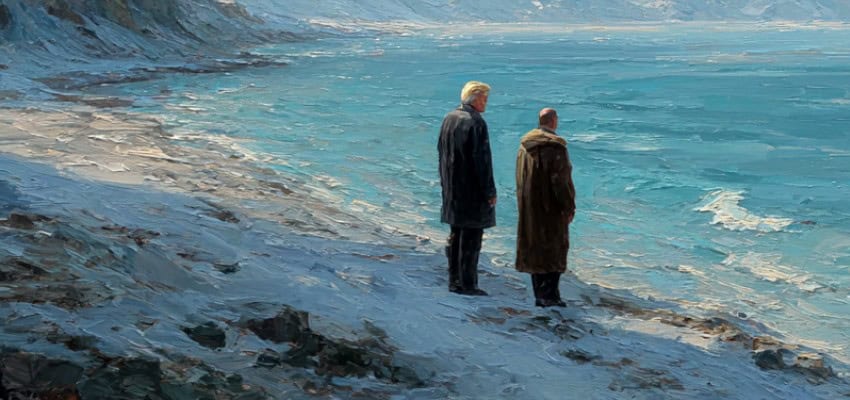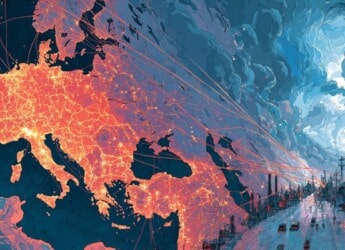Editor’s Note: Russia’s war in Ukraine is now unfolding on two parallel fronts — the unrelenting attrition of the battlefield and the strategic maneuvering of high-stakes diplomacy. This latest ComplexDiscovery analysis, anchored in the August 9, 2025, assessment from the Institute for the Study of War, weaves together these strands to provide a unified view. On the ground, it examines Ukrainian counterattacks near Kupyansk, persistent Russian offensives in Donetsk, and targeted Ukrainian strikes on Russian drone infrastructure. In the diplomatic arena, it dissects the opaque and conflicting accounts of Russian President Vladimir Putin’s reported ceasefire terms and Kyiv’s counterproposals, all in the lead-up to the August 15 Alaska summit between U.S. President Donald Trump and Putin. For professionals in geopolitical risk, national security, and eDiscovery contexts, this article underscores the intertwined nature of military realities and political narratives — and how the outcome in one arena will inevitably shape the other.
For those seeking to grasp the full scope of this evolving landscape, the complete updates from the Institute for the Study of War serve as an invaluable resource.
Content Assessment: Alaska as a Stage: How Symbolism Shapes the Ukraine War’s Next Phase
Information - 93%
Insight - 92%
Relevance - 94%
Objectivity - 95%
Authority - 96%
94%
Excellent
A short percentage-based assessment of the qualitative benefit expressed as a percentage of positive reception of the recent article from ComplexDiscovery OÜ titled, "Alaska as a Stage: How Symbolism Shapes the Ukraine War’s Next Phase."
Background Note: ComplexDiscovery’s staff offers distinctive perspectives on the Russo-Ukrainian war and Middle Eastern conflicts, informed by their military experience on the West German, East German, and Czechoslovakian borders during the Cold War, as well as in Sinai as part of Camp David Accord compliance activities, during the timeframe of the Persian Gulf War. This firsthand regional knowledge has been further enhanced by recent staff travels to Eastern European countries, including Estonia, Finland, Latvia, Lithuania, and Poland. These visits have provided up-to-date, on-the-ground insights into the current geopolitical climate in regions directly impacted by the ongoing conflict.
Combined with cybersecurity, information governance, and eDiscovery proficiency, this multifaceted experience enables comprehensive analysis of these conflicts, including the critical impact of cyber warfare, disinformation, and digital forensics on modern military engagements. This unique background positions ComplexDiscovery to provide valuable insights for conflict-related investigations and litigation, where understanding the interplay of technology, data, and geopolitical factors is crucial.
Russo-Ukrainian Conflict Update*
Alaska as a Stage: How Symbolism Shapes the Ukraine War’s Next Phase
ComplexDiscovery Staff
As the war in Ukraine grinds through another summer, both battlefield clashes and high-level diplomacy are shaping its trajectory. The political theater surrounding possible ceasefire terms has become almost as contentious as the fighting itself, with conflicting interpretations of Russian President Vladimir Putin’s reported offers creating uncertainty in Western capitals. While the details vary, one point remains constant — Moscow’s demand that Ukraine abandon the remaining government-held portions of Donetsk Oblast, a fortified defensive belt that has resisted Russian advances for over a decade.
From there, the accounts diverge. Early reports suggested that Putin had signaled a willingness to withdraw from occupied sectors of Zaporizhia and Kherson in return for Ukrainian concessions elsewhere. Subsequent clarifications recast these remarks as a demand for unilateral Ukrainian withdrawals without any confirmed Russian pullback. Other accounts added offers to abandon parts of Kharkiv and Sumy as a “goodwill gesture,” while some described a maximalist package including recognition of Russian sovereignty over Crimea and the entirety of Donetsk and Luhansk oblasts. These inconsistencies leave the Kremlin’s actual position deliberately opaque, giving Moscow room to shape the narrative to different audiences.
Kyiv, supported by key European leaders, has responded with a counterproposal that flips the sequence: a comprehensive ceasefire first, followed by reciprocal territorial negotiations. This approach would be buttressed by binding security guarantees designed to prevent a repeat of the invasion. London, Paris, and several Baltic and Eastern European capitals have reinforced public backing for this stance, signaling that Ukraine will not be pressured into territorial concessions as a precondition for peace.
While these diplomatic skirmishes play out, preparations continue for an August 15 meeting between U.S. President Donald Trump and Putin in Alaska — a location Russian officials have woven into a longstanding propaganda motif. Kremlin voices have pointed to Alaska’s geographic proximity, shared Arctic interests, and even 19th-century imperial history as evidence of “historic ties,” reviving claims that the territory should one day return to Russian control. The choice of venue thus serves both symbolic and psychological functions, projecting confidence and playing to nationalist narratives at home.
On the ground, Ukraine has maintained its pattern of deep strikes into Russia’s military-industrial network, hitting a Shahed drone storage site in Tatarstan and reportedly conducting sabotage against an air defense unit in Krasnodar Krai. Moscow, for its part, appears to be adjusting its command structure in the north, with unconfirmed reports that Colonel General Yevgeny Nikiforov has replaced Colonel General Alexander Lapin after criticism of the latter’s handling of operations in Sumy and Kharkiv.
The frontlines themselves have shifted only modestly. Ukrainian troops have regained ground southwest of Kindrashivka near Kupyansk, while Russian forces push in multiple sectors from Sumy to eastern Donetsk. Engagements near Vovchansk, Lyman, Chasiv Yar, Toretsk, and Pokrovsk remain fierce, but neither side has secured decisive breakthroughs. In the south, Russia continues to press in Zaporizhia and Kherson oblasts, although gains are minimal and often contested.
The air war remains relentless. In a single overnight operation, Russia launched nearly fifty Shahed-type drones and two cruise missiles against a mix of frontline and rear-area targets, damaging civilian infrastructure and striking a former hospital in Zolochiv. Ukrainian air defenses intercepted part of the attack, but the persistence of these barrages underscores Moscow’s intent to sap both Ukraine’s defenses and civilian morale.
Taken together, these developments illustrate a war now balanced on two precarious edges: one at the negotiation table, where terms are fluid and potentially deceptive, and another on the battlefield, where attrition grinds down both sides without producing decisive momentum. As Alaska looms on the diplomatic calendar, the central question is not just whether a ceasefire can be agreed, but whether any such deal would mark the beginning of a lasting peace — or merely set the stage for a more dangerous resumption of hostilities.
Detailed Reporting with Maps for August 9, 2025, from the ISW – Mouseover to Scroll
Russo-Ukrainian War August 09 2025Review the Detailed Reporting and Maps PDF
About the Institute for the Study of War Research Methodology
ISW’s research methodology relies on both primary and secondary sources, enabling researchers to develop a comprehensive understanding of the situation on the ground. In order to analyze military and political developments in any given area, ISW’s research analysts must wholly understand the systems of enemy and friendly forces. They must also understand the population demographics, physical terrain, politics, and history of that area. This lays the analytical foundation for understanding the reasons for particular developments and fulfilling their assigned research objectives. ISW analysts also spend time in places like Iraq, Afghanistan, and elsewhere in order to gain a better understanding of the security and political situation and to evaluate the implementation of current strategies and policies. Their researchers compile data and analyze trends, producing a granular analysis of developments in areas of research, producing an accurate, high-resolution, timely, and thorough picture of the situation. ISW’s research methodology guarantees its success and commitment to improving the nation’s ability to execute military operations, achieve strategic objectives, and respond to emerging problems that may require the use of American military power.
About the Institute for the Study of War
The Institute for the Study of War advances an informed understanding of military affairs through reliable research, trusted analysis, and innovative education. They are committed to improving the nation’s ability to execute military operations and respond to emerging threats in order to achieve U.S. strategic objectives. ISW is a non-partisan, non-profit, public policy research organization.
Learn more, get involved, and contribute today.
Assisted by GAI and LLM Technologies
* Sourced and shared with direct expressed permission from the Institute for the Study of War (ISW).
Additional Reading
- From Dissent to OSINT? Understanding, Influencing, and Protecting Roles, Reputation, and Revenue
- Data Embassies: Sovereignty, Security, and Continuity for Nation-States
Source: ComplexDiscovery OÜ
























